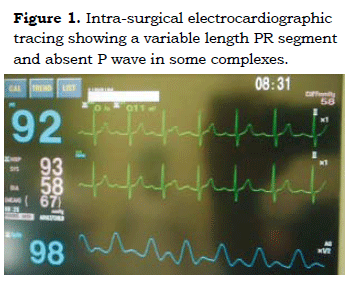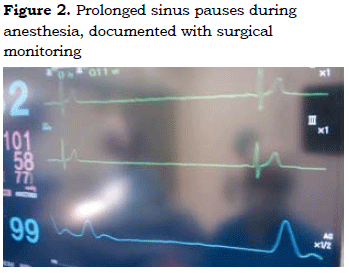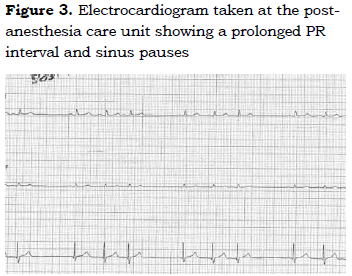Services on Demand
Journal
Article
Indicators
-
 Cited by SciELO
Cited by SciELO -
 Access statistics
Access statistics
Related links
-
 Cited by Google
Cited by Google -
 Similars in
SciELO
Similars in
SciELO -
 Similars in Google
Similars in Google
Share
Colombian Journal of Anestesiology
Print version ISSN 0120-3347
Rev. colomb. anestesiol. vol.39 no.2 Bogotá Apr./July 2011
https://doi.org/10.5554/rca.v39i2.78
CASE REPORT
Intra-operative Arrhythmias: Sick Sinus Syndrome Manifested During General Anesthesia
Juan Carlos Bocanegra Rivera*, Juliana Caicedo Salazar**
* Médico anestesiólogo. SES Hospital de Caldas, Instituto del Corazón. Catedrático Anestesiologia Universidad de Caldas. Colombia. Correspondencia: Calle 81B No. 25-41 Conjunto Bosques de la Sierra Casa 01 Manizales, Colombia. Correo electrónico: bocanegra67@yahoo.co
** Médico residente de segundo año de Anestesiología, Universidad de Caldas. Manizales, Colombia. Correo electrónico: juliana_caicedo@hotmail.com
Recibido: agosto 9 de 2010. Enviado para modificaciones: agosto 31 de 2010. Aceptado: abril 1 de 2011.
SUMMARY
Arrhythmias are a frequent occurrence in the daily practice of anesthesia and there are several factors implicated, including the drugs used for induction and maintenance of anesthesia. A case is presented of a 38-year old male patient, previously healthy, who developed a sick sinus syndrome manifested in the form of an accelerated nodal rhythm during general anesthesia, which reverted to sinus rhythm without requiring specific management. This condition is associated with multiple etiologies and its electrocardiographic manifestations may be diverse. It is important to recognize intra-operative arrhythmias, identify their possible causes, and treat them when necessary.
Keywords: Arrhythmias, cardiac, anesthesia, sick sinus syndrome, tachycardia. (Source: MeSH, NLM).
INTRODUCTION
Intra-operative arrhythmias are among the most common complications in the practice of anesthesia. Their incidence is close to 70% in noncardiac surgery, and they may appear as a manifestation of a serious disorder such as myocardial ischemia, cerebrovascular alterations or cardiac arrest, although they are usually benign transient disorders that may resolve spontaneously or with simple interventions. The duration of the arrhythmia, the associated ventricular response and the underlying cardiac function determine the physiological impact of an intra-operative arrhythmia in any given patient. The forms most commonly found include atrial pacemaker migration; isorrhythmic AV dissociation; nodal rhythm; suprventricular extrasystoles; supraventricular and ventricular paroxysmal tachycardia (1-5).
Inhaled and intravenous anesthetics have shown to have an effect on cardiac conduction, repolarization and automatism, hence the possibility of occurrence of those clinical events during the administration of anesthesia. Knowledge of the arrhythmogenic mechanisms and of the drugs used routinely will enable the anesthesiologist to make a correct diagnosis and provide relevant treatment to patients presenting this condition (4,6,7).
CASE REPORT
Thirty-eight year old male patient from a rural area in Caldas, scheduled for inguinal hernia repair, with no previous history of disease, surgery or allergy. The following information was recorded during the pre-anesthesia assessment: weight, 78 kg; blood pressure, 113/68; heart rate, 72 per minute, with rhythmic heart sounds. No pre-operative laboratory tests were requested.
General anesthesia was given under conventional monitoring. The electrocardiographic recording before induction showed normal sinus rhythm. Induction was given with intravenous propofol 200 mg, remifentanil 80 μg and rocuronium 20 mg. A No. 4 laryngeal mask was used for airway management. Maintenance anesthesia was given using sevoflurane at an initial dose of 2 %, tapered down to 0.15 and 0.12 μg/kg/min. Analgesia was administered using de morphine 10 mg, dipirone 3 g, ketamine 25 mg and diclofenac 75 mg.
The total operative time was 1 hour and 10 minutes. After induction, the monitor began to show variable P-R intervals together with prolonged sinus pauses, but no associated bradycardia or hypotension (figs. 1 and 2), hence the decision not to provide pharmacological intervention. This rhythm resolved spontaneously and the patient was hemodynamically and clinically stable upon emergence from anesthesia.
A follow-up electrocardiogram was performed in the post-anesthetic care unit, and no rhythm or heart rate abnormalities were found. After 30 minutes, the patient experienced an episode of lipothymia associated with bradycardia, a heart rate of 35 per minute and blood pressure of 80/40. He received intravenous atropine 1mg and the bradycardia was resolved. A new electrocardiogram was performed (Fig. 3) and the patient was transferred to the intensive care unit for monitoring and assessment by the cardiologist.
When asked, the patient denied having had prior episodes of syncope, lipthymia or palpitations; he also denied having experienced any symptoms with exercise, or having used psychoactive drugs.
The electrocardiographic holter test performed in the hospital showed 2 ventricular ectopies and 15 % of the overall monitored beats in bradycardia as the only abnormal findings. After assessment by the cardiologist, no additional diagnostic testing was considered necessary, and the patient was discharged although he remained in the hospital for 2 more days. No new episodes of arrhythmia or lipothymia were reported and the patient remained hemodynamically stable.
SICK SINUS SYNDROME
The sick sinus syndrome is described as an abnormality in the formation of the electric impulse in the heart, preventing the correct natural pacemaker function of the sinus node. A large number of etiologies have been described, in particular underlying diseases causing fibrosis or tissue degeneration, such as collagenoses, amyloidoses and muscle dystrophies. However, most cases are considered idiopathic.
A higher incidence has typically been described in elderly patients, although it may occur in all age groups, even in neonates. The electrocardiographic manifestations are varied, including isolated or alternating bradyarrhythmias and tachyarrhythmias. Sixty per cent of cases correspond to tachyarrhythmia, but junction rhythm, sinus arrest, atrial fibrillation and AV blocks may also appear as electrocardiographic manifestations of this condition (8,9).
The manifestation in the case reported in this study was accelerated nodal rhythm, given the narrow QRS complexes, with no associated bradycardia, and shortening of the PR interval. The morphology of the ventricular complexes was not altered because the depolarization followed the bundle of His; P waves may be seen on occasions within the QRS complex or in the form of negative waves. This rhythm occurs when the sinus node, the natural pacemaker of the heart, fails to initiate the impulse and the AV node takes over (10).
This condition may be difficult to diagnose because symptoms do not manifest early on; the only early finding of sinus dysfunction may be bradycardia, and late symptoms are non-specific, including dizziness, fatigue, irritability, palpitations and syncope, all of which could be attributed to multiple causes not necessarily associated with the cardiovascular system.
On the other hand, if the electrocardiogram or the monitoring are performed while the patient is asymptomatic, the results may be normal, because this disorder is usually intermittent. Isoproterenol and atropine tests, under careful electrocardiographic monitoring, may also be useful for diagnosis. In contrast, the sensitivity and specificity of the electrophysiological tests are poor and, consequently, they are not recommended for routine use as part of the workup for this disorder (8).
The definitive treatment of this condition, whether it manifests in the form of bradyarrhythmias or tachyarrhythmias, is permanent pacemaker placement. It is worth noting that anti-arrhythmic medications such as digitalis, beta-blockers and calcium antagonists may worsen the bradycardia as the underlying cause of the sick sinus syndrome. Once the pacemaker is in place, the prognosis for this condition is good, and mortality is comparable to that of the general population (4,8,11-13).
ANESTHESIA AND ARRHYTHMIAS
In surgery, several conditions may be associated with the onset of arrhythmias, including, among others, electrolyte and acid-base alterations, hypothermia, existing heart disease and vagal reflexes triggered by the surgery (1-4).
Anesthetic agents in general, inhaled and intravenous alike, may have arrhythmogenic effects. Halogenated agents reduce sinus node automatism and conduction velocity, while propofol may produce sinus bradycardia and AV block, and etomidate reduces AV conduction. Opioids also reduce conduction, produce bradycardia and may give rise to nodal rhythms. None of these effects are significant in patients with a healthy heart, but they may reveal, trigger or aggravate existing disorders (4).
There are several cases reported in the literature about sick sinus syndrome manifested during the administration of general anesthesia, including bradycardia unresponsive to conventional management. This may be due to the electrophysiological changes created by the anesthetic agents, as already mentioned. This type of bradycardia has been treated definitively with the placement of a permanent pacemaker, in view of the poor response to pharmacological management (9,11-13).
DISCUSSION
The case presented in this study is that of a healthy young patient with no previous history of disease, scheduled for elective surgery, who develops intra-operative sinus node dysfunction, manifested in the form of accelerated sinus rhythm, possibly as a result of the drugs administered as part of the general anesthesia.
This patient did not require definitive interventions because the sinus rhythm recovered spontaneously, although he may develop a clinically- evident sick sinus syndrome requiring the placement of a permanent pacemaker in the future. Intra-operative arrhythmias occur frequently in daily practice, hence the need for the anesthesiologist to be familiar with their diagnosis and treatment, and the various factors that may trigger them.
The case presented in the study is just one example of the cardiac rhythm alterations that may occur during the administration of anesthesia, and of how it is critical to be able to recognize them. However, more important still is the need to define the implications for the patient and whether a specific intervention is required or not.
REFERENCES
1. Almendral Garrote J, Navia Roque J, Zeballos García M. Anestesia y electrofisiología cardiaca (Parte I). Rev Esp Anestesiol Reanim. 2005;52:276-89.
2. Almendral Garrote J, Navia Roque J, Zeballos García M. Manejo perioperatorio de las arritmias cardiacas (Parte II). Rev Esp Anestesiol Reanim. 2006;53:1 63-83.
3. Galindo M. Arritmias perioperatorias diagnóstico y manejo. Rev. Col. Anest. 1989;17:367-76. 4. Atlee JL 3rd, Bosnjak ZJ. Mechanisms for cardiac dysrhythmias during anesthesia. Anesthesiology. 1990;72:347-74.
5. Kuner J, Enescu V, Utsu F, et al. Cardiac arrhythmias during anesthesia. Dis Chest. 1967;52:580-7.
6. Mizuno J, Morita S, Kamiya K, et al. Isorhythmic dissociation during sevoflurane anesthesia. Masui. 2009;58:645-8.
7. Kweon TD, Nam SB, Chang CH, et al. The effect of bolus administration of remifentanil on QTc interval during induction of sevoflurane anaesthesia. Anaesthesia. 2008;63:347-51.
8. Adán V, Crown LA. Diagnosis and treatment of sick sinus syndrome. Am Fam Physician. 2003;67: 1725-32.
9. Pratila MG, Pratilas V. Sick-sinus syndrome manifested during anesthesia. Anesthesiology. 1976;44: 433-6.
10. Bogran A. Ritmo nodal con onda P positiva. Rev Med Hondur. 1975;43:227-30.
11. Hirata A, Kitagawa H, Komoda Y, et al. Sick sinus syndrome discovered after induction of general anesthesia in a patient with normal preoperative Holter ECG. Masui. 1994;43:1048-52.
12. Nakamura S, Nishiyama T, Hanaoka K. General anesthesia for a patient with asymptomatic sick sinus syndrome. Masui. 2005;54:912-3.
13. Gregoratos G, Cheitlin MD, Conill A, et al. ACC/AHA guidelines for implantation of cardiac pacemakers and antiarrhythmia devices: a report of the American College of Cardiology/American Heart Association Task Force on Practice Guidelines (Committee on Pacemaker Implantation). J Am Coll Cardiol 1998;31:1175-209.
1. Almendral Garrote J, Navia Roque J, Zeballos García M. Anestesia y electrofisiología cardiaca (Parte I). Rev Esp Anestesiol Reanim. 2005;52:276-89. [ Links ]
2. Almendral Garrote J, Navia Roque J, Zeballos García M. Manejo perioperatorio de las arritmias cardiacas (Parte II). Rev Esp Anestesiol Reanim. 2006;53:1 63-83. [ Links ]
3. Galindo M. Arritmias perioperatorias diagnóstico y manejo. Rev. colomb. anestesiol. 1989;17:367-76. [ Links ]
4. Atlee JL 3rd, Bosnjak ZJ. Mechanisms for cardiac dysrhythmias during anesthesia. Anesthesiology. 1990;72:347-74. [ Links ]
5. Kuner J, Enescu V, Utsu F, et al . Cardiac arrhythmias during anesthesia. Dis Chest. 1967;52:580-7. [ Links ]
6. Mizuno J, Morita S, Kamiya K, et al . Isorhythmic dissociation during sevoflurane anesthesia. Masui. 2009;58:645-8. [ Links ]
7. Kweon TD, Nam SB, Chang CH, et al . The effect of bolus administration of remifentanil on QTc interval during induction of sevoflurane anaesthesia. Anaesthesia. 2008;63:347-51. [ Links ]
8. Adán V, Crown LA. Diagnosis and treatment of sick sinus syndrome. Am Fam Physician. 2003;67: 1725-32. [ Links ]
9. Pratila MG, Pratilas V. Sick-sinus syndrome manifested during anesthesia. Anesthesiology. 1976;44: 433-6. [ Links ]
10. Bogran A. Ritmo nodal con onda P positiva. Rev Med Hondur. 1975;43:227-30. [ Links ]
11. Hirata A, Kitagawa H, Komoda Y, et al . Sick sinus syndrome discovered after induction of general anesthesia in a patient with normal preoperative Holter ECG. Masui. 1994;43:1048-52. [ Links ]
12. Nakamura S, Nishiyama T, Hanaoka K. General anesthesia for a patient with asymptomatic sick sinus syndrome. Masui. 2005;54:912-3. [ Links ]
13. Gregoratos G, Cheitlin MD, Conill A, et al . ACC/AHA guidelines for implantation of cardiac pacemakers and antiarrhythmia devices: a report of the American College of Cardiology/American Heart Association Task Force on Practice Guidelines (Committee on Pacemaker Implantation). J Am Coll Cardiol 1998;31:1175-209. [ Links ]











 text in
text in 




